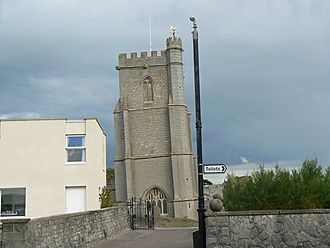St Andrew's Church, Burnham-on-Sea facts for kids
Quick facts for kids St. Andrew's Church |
|||||||||
|---|---|---|---|---|---|---|---|---|---|
 |
|||||||||
| General information | |||||||||
| Location | Victoria Street, Burnham-on-Sea, Somerset TA8 1AW | ||||||||
| Country | England | ||||||||
| Construction started | 1305 | ||||||||
| Completed | 1314 | ||||||||
|
|||||||||
St Andrew's Church is a very old church in Burnham-on-Sea, a town in Somerset, England. It is part of the Church of England. This church is famous for its tower, which leans to one side! It is also a "Grade I listed building," which means it's a very important historical building.
Contents
History of the Church
There has been a church on this spot for a very long time, since the late 1000s. The church you see today was built or improved between 1305 and 1314. Some parts from that time are still standing, like the arch of the south door.
The church tower was built in the late 1300s. The main part of the church, called the nave, was built around the same time or in the early 1400s. Later, in 1838, a new section called the north aisle and a gallery were added. The area around the altar, called the chancel, was updated in 1878.
The Leaning Tower
The tower of St Andrew's Church is about 24 meters (78 feet) tall. It leans quite a bit, which makes it a popular sight for visitors. If you dropped a straight line from the north side of the tower, it would land about 1 meter (3 feet) away from the building!
Experts believe the tower leans because its foundations, which are the parts of the building under the ground, are not very strong.
The Tower as a Lighthouse
In the 1700s, a light was placed on the church tower. This light helped guide fishing boats safely into the harbour. Later, in 1799, a local vicar (a church leader) named Walter Harris helped raise money to replace the light.
A new, round tower was built next to the church in 1801. This tower was four stories high and also served as a lighthouse. In 1829, a group called Trinity House, which manages lighthouses, took over and improved it. The money from this sale was used to make the area nicer, hoping to attract visitors to Burnham-on-Sea as a spa town.
Trinity House used this lighthouse until 1832. After that, two new lighthouses, the High Lighthouse and Low Lighthouse, took its place. The round tower was later made shorter, with only two stories, so people wouldn't confuse it with the High Lighthouse.
The church tower also has a set of eight bells. These bells are used for a special type of bell ringing called change ringing. The bells were made by the Whitechapel Bell Foundry, a famous bell-making company.
Special Sculptures
Inside St Andrew's Church, you can see some beautiful marble carvings. These were designed by a famous architect named Sir Christopher Wren. They were originally made for a private chapel in the Palace of Whitehall in London.
These sculptures were part of a large altar ordered by King James II in 1685. They were carved by Inigo Jones and other artists, including a Belgian artist named Arnold Quellin.
The sculptures were first moved to Westminster Abbey in 1706. Then, in the late 1700s or early 1800s, they were brought to Burnham-on-Sea. This happened because Walker King, who was a bishop and also the vicar of Burnham-on-Sea, got them for the church. He even wrote a small book about them, which he sold to raise money for charity.
What you see at Burnham is only part of the original artwork. The main panels are behind the altar, and other pieces are displayed in different parts of the church.
See also
- List of ecclesiastical parishes in the Diocese of Bath and Wells

